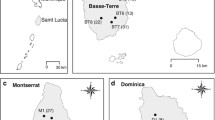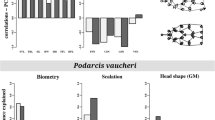Abstract
The study of the association between morphological and genetic divergence can provide important information on the factors determining population differentiation and gene flow at different spatiotemporal scales. In this study we analyze the congruence between morphological and genetic divergence in the Iberian populations of Mioscirtus wagneri, a specialized grasshopper exclusively inhabiting highly fragmented hypersaline low grounds. We have found strong morphological variation among the studied localities and among mtDNA- and microsatellite-based genetic clusters. However, we have detected some cases of morphological convergence between highly differentiated populations. By contrast, certain genetically homogeneous populations at both mtDNA and microsatellite markers showed significant morphological differentiation which may be explained by phenotypic plasticity or divergent selection pressures acting at different spatiotemporal scales. Mantel tests also revealed that morphological divergence was associated with microsatellite- but not with mtDNA-based genetic distances. Overall, this study suggests that morphological traits can provide additional information on the underlying population genetic structure when only data on scarcely variable mtDNA markers is available. Thus, morphology can retain useful information on genetic structure and has the benefit over molecular methods of being inexpensive, offering a preliminary/complementary useful criterion for the establishment of management units necessary to guide conservation policies.



Similar content being viewed by others
References
Aguirre MP, Bloor P, Ramírez-Escobar U, Ortego J, Cordero PJ (2010) Isolation and characterization of polymorphic microsatellite markers in the grasshopper Mioscirtus wagneri (Orthoptera: Acrididae). Conserv Genet 11:1119–1121
Barton NH (2001) Speciation. Trends Ecol Evol 16:325
Bonnet E, Van de Peer Y (2002) ZT: a software tool for simple and partial Mantel tests. J Stat Softw 10:1–12
Charlesworth B, Lande R, Slatkin M (1982) A neo-Darwinian commentary on macroevolution. Evolution 36:474–498
Cordero PJ, Llorente V, Aparicio JM (2007) New data on morphometrics, distribution and ecology of Mioscirtus wagneri (Kittary, 1859) (Orthoptera: Acrididae) in Spain: is maghrebi a well defined subspecies? Graellsia 63:3–16
Dupanloup I, Schneider S, Excoffier L (2002) A simulated annealing approach to define the genetic structure of populations. Mol Ecol 11:2571–2581
Excoffier L, Laval G, Schneider S (2005) Arlequin ver. 3.0: an integrated software package for population genetics data analysis. Evol Bioinform Online 1:47–50
Frankham R (1995) Conservation genetics. Annu Rev Genet 29:305–327
Frankham R (1996) Relationship of genetic variation to population size in wildlife. Conserv Biol 10:1500–1508
Funk WC, Cannatella DC, Ryan MJ (2009) Genetic divergence is more tightly related to call variation than landscape features in the Amazonian frogs Physalaemus petersi and P. freibergi. J Evol Biol 22:1839–1853
García JT, Suárez F, Garza V, Calero-Riestra M, Hernández J, Pérez-Tris J (2008) Genetic and phenotypic variation among geographically isolated populations of the globally threatened Dupont’s lark Chersophilus duponti. Mol Phylogenet Evol 46:237–251
Garnier S, Magniez-Jannin F, Rasplus JY, Alibert P (2005) When morphometry meets genetics: inferring the phylogeography of Carabus solieri using Fourier analyses of pronotum and male genitalia. J Evol Biol 18:269–280
Greenberg R, Cordero PJ, Droege S, Fleischer RC (1998) Morphological adaptation with no mitochondrial DNA differentiation in the coastal plain swamp sparrow. Auk 115:706–712
Heidinger IMM, Hein S, Bonte D (2010) Patch connectivity and sand dynamics affect dispersal-related morphology of the blue-winged grasshopper Oedipoda caerulescens in coastal grey dunes. Insect Conserv Divers 3:205–212
Illera JC, Emerson BC, Richardson DS (2007) Population history of Berthelot’s pipit: colonization, gene flow and morphological divergence in Macaronesia. Mol Ecol 16:4599–4612
Jackson DA (1993) Stopping rules in principal components analysis–a comparison of heuristic and statistical approaches. Ecology 74:2204–2214
Lee CE, Frost BW (2002) Morphological stasis in the Eurytemora affinis species complex (Copepoda: Temoridae). Hydrobiologia 480:111–128
Milá B, Wayne RK, Fitze P, Smith TB (2009) Divergence with gene flow and fine-scale phylogeographical structure in the wedge-billed woodcreeper, Glyphorynchus spirurus, a neotropical rainforest bird. Mol Ecol 18:2979–2995
Nice CC, Shapiro AM (1999) Molecular and morphological divergence in the butterfly genus Lycaeides (Lepidoptera: Lycaenidae) in North America: evidence of recent speciation. J Evol Biol 12:936–950
Ortego J, Bonal R, Cordero PJ, Aparicio JM (2009) Phylogeography of the Iberian populations of Mioscirtus wagneri (Orthoptera: Acrididae), a specialized grasshopper inhabiting highly fragmented hypersaline environments. Biol J Linnean Soc 97:623–633
Ortego J, Aguirre MP, Cordero PJ (2010) Population genetics of Mioscirtus wagneri, a grasshopper showing a highly fragmented distribution. Mol Ecol 19:472–483
Panhuis TM, Butlin R, Zuk M, Tregenza T (2001) Sexual selection and speciation. Trends Ecol Evol 16:364–371
Pigliucci M (2001) Phenotypic plasticity: beyond nature and nurture. The Johns Hopkins University Press, Baltimore
Polihronakis M (2009) Hierarchical comparative analysis of genetic and genitalic geographical structure: testing patterns of male and female genital evolution in the scarab beetle Phyllophaga hirticula (Coleoptera: Scarabaeidae). Biol J Linnean Soc 96:135–149
Pritchard JK, Stephens M, Donnelly P (2000) Inference of population structure using multilocus genotype data. Genetics 155:945–959
Ramírez-Valiente JA, Lorenzo Z, Soto A, Valladares F, Gil L, Aranda I (2009) Elucidating the role of genetic drift and natural selection in cork oak differentiation regarding drought tolerance. Mol Ecol 18:3803–3815
Saunders DA, Hobbs RJ, Margules CR (1991) Biological consequences of ecosystem fragmentation–a review. Conserv Biol 5:18–32
Schauble CS (2004) Variation in body size and sexual dimorphism across geographical and environmental space in the frogs Limnodynastes tasmaniensis and L. peronii. Biol J Linnean Soc 82:39–56
Schluter D (2001) Ecology and the origin of species. Trends Ecol Evol 16:372–380
Slatkin M (1987) Gene flow and the geographic structure of natural populations. Science 236:787–792
Smith TB, Wayne RK, Girman DJ, Bruford MW (1997) A role for ecotones in generating rainforest biodiversity. Science 276:1855–1857
Smith TB, Calsbeek R, Wayne RK, Holder KH, Pires D, Bardeleben C (2005) Testing alternative mechanisms of evolutionary divergence in an African rain forest passerine bird. J Evol Biol 18:257–268
Strange JP, Garnery L, Sheppard WS (2008) Morphological and molecular characterization of the Landes honey bee (Apis mellifera L.) ecotype for genetic conservation. J Insect Conserv 12:527–537
Telfer MG, Hassall M (1999) Ecotypic differentiation in the grasshopper Chorthippus brunneus: life history varies in relation to climate. Oecologia 121:245–254
Toju H, Sota T (2009) Do arms races punctuate evolutionary stasis? Unified insights from phylogeny, phylogeography and microevolutionary processes. Mol Ecol 18:3940–3954
Turelli M, Barton NH, Coyne JA (2001) Theory and speciation. Trends Ecol Evol 16:330–343
Tzika AC, Rosa SFP, Fabiani A, Snell HL, Snell HM, Marquez C, Tapia W, Rassmann K, Gentile G, Milinkovitch MC (2008) Population genetics of Galapagos land iguana (genus Conolophus) remnant populations. Mol Ecol 17:4943–4952
Vandergast AG, Lewallen EA, Deas J, Bohonak AJ, Weissman DB, Fisher RN (2009) Loss of genetic connectivity and diversity in urban microreserves in a southern California endemic Jerusalem cricket (Orthoptera: Stenopelmatidae: Stenopelmatus n. sp “santa monica”). J Insect Conserv 13:329–345
Wang IJ, Summers K (2010) Genetic structure is correlated with phenotypic divergence rather than geographic isolation in the highly polymorphic strawberry poison-dart frog. Mol Ecol 19:447–458
Whitman DW (2008) The significance of body size in the orthoptera: a review. J Orthoptera Res 17:117–134
Acknowledgements
Two anonymous referees provided useful discussion and valuable comments on an earlier draft of this manuscript. This work received financial support from the projects PCI08-0130 (JCCM), POII09-0198-8057 (JCCM), PEII11-0161-4455 (JCCM), and CGL2008-00095/BOS (MICINN). The study was funded by a post-doctoral JAE-Doc (CSIC) contract (to J.O.) and a research contract from the Junta de Comunidades de Castilla-La Mancha/European Social Fund (to P.A.).
Author information
Authors and Affiliations
Corresponding author
Electronic supplementary material
Below is the link to the electronic supplementary material.
Rights and permissions
About this article
Cite this article
Ortego, J., Aguirre, M.P. & Cordero, P.J. Genetic and morphological divergence at different spatiotemporal scales in the grasshopper Mioscirtus wagneri (Orthoptera: Acrididae). J Insect Conserv 16, 103–110 (2012). https://doi.org/10.1007/s10841-011-9397-4
Received:
Accepted:
Published:
Issue Date:
DOI: https://doi.org/10.1007/s10841-011-9397-4




